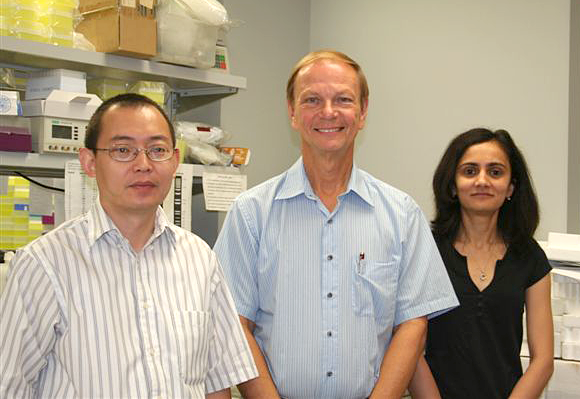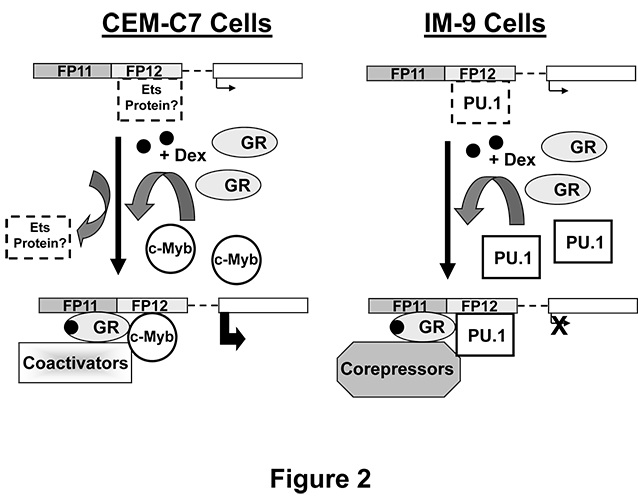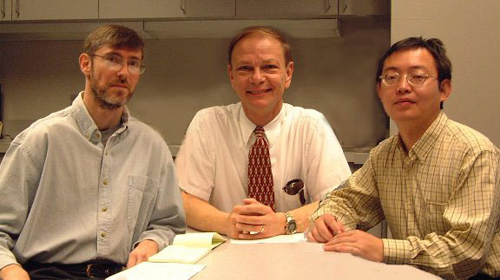The glucocorticoid receptor (GR) is a ligand-activated transcription factor that regulates the expression of many genes in various cell types. Glucocorticoid hormone treatment of non-apoptotic cells causes an autologous down-regulation of GR expression [Barrett, Vig, and Vedeckis, Biochemistry 35, 9746-9753, (1996)], and this may desensitize the cell to hormone to maintain homeostasis. However, there is an autologous up-regulation of GR expression in immature T-cells, thymocytes, and leukemic T-lymphoblasts that undergo terminal differentiation and apoptosis in response to the hormone [Barrett, Vig, and Vedeckis, Biochemistry 35, 9746-9753, (1996)]. This makes biological sense, as an augmentation in the signal transduction pathway by the effector (hormone) would bring about these programmed, terminal events.
A proximal promoter sequence (2.7 kbp) has been isolated, cloned and characterized for the human GR gene [Breslin and Vedeckis, J. Steroid Biochem. Molec. Biol. 67, 369-381, (1998) and references therein]. Using 5'-RACE (rapid amplification of cDNA ends), our lab has discovered that there are five different untranslated exon 1 sequences spliced to the GR mRNA protein coding sequences (which begin in exon 2) [Breslin, Geng, and Vedeckis, Mol. Endocrinol 15, 1381-1395, (2001)]. These five primary transcripts arise from the alternative usage of three promoters plus alternative splicing (Fig. 1). One promoter (1C) is a GC-rich, Sp1 transcription factor binding sequence found in many housekeeping genes. Our lab has also found a previously undescribed promoter (1B) that appears to be controlled predominantly by three Yin Yang 1 transcription factor binding sites, which control the synthesis of an untranslated exon 1B [Nunez and Vedeckis, Mol. Cell. Endocrinol. 189, 191-199 (2002)]. Both of these promoters (1B and 1C) and their corresponding untranslated exon sequences are found in the published, 2.7 kbp, human GR "promoter" sequence. However, an entirely new sequence, designated the 1A promoter and untranslated exon, was also discovered using 5' RACE. Three different untranslated exon 1A sequences (1A1, 1A2, and 1A3) arise from the usage of GR promoter 1A. mRNAs containing exon 1A1 and 1A2 are found in all cell lines tested, while exon 1A3-containing mRNA is found only in hematopoietic cells. Most importantly, exon 1A3-containing sequences are highest in CEM-C7, T-lymphoblast cells, and their level is strongly up-regulated (>8-fold) by glucocorticoid hormone treatment [Pedersen and Vedeckis, Biochemistry 42, 10978-10990, (2003); Pedersen, Geng, and Vedeckis, Biochemistry 43, 10851-10858, (2004)]. Extensive studies from our lab [Geng and Vedeckis,Mol.Endocrinol. 18, 912-924 (2004); Geng and Vedeckis, J. Biol. Chem. 280, 43264-43271 (2005)] have identified a novel glucocorticoid responsive unit (GRU) in promoter 1A that contains a nonconsensus 1/2 GR binding site adjacent to overlapping c-Myb and c-Ets protein binding sites. An essential feature of the latter DNA binding site is that either c-Myb or a c-Ets protein, but notbothsimultaneously, can bind to the DNA. Binding of either protein is mutually exclusive of the other. This has led to a "molecular switch hypothesis to explain the opposite hormonal auto-regulation of GR gene expression (Fig. 2). We propose that the simultaneous binding of the GR and c-Myb causes an auto-up-regulation in certain cell types (like CEM C-7, T-cell acute lymphoblastic leukemia (ALL) cells) that are programmed to undergo hormone-mediated apoptosis. The GR/c-Myb complex then recruits various coactivators, resulting in an increase in GR gene transcription and intracellular GR protein levels. Steroid-dependent auto-down-regulation occurs when a c-Ets protein family member (such as PU.1) binds adjacent to the GR in the GR 1A promoter. The GR/PU.1 complex recruits corepressors that cause a decrease in GR gene transcription and lowered levels of intracellular GR protein. A fundamental principle of this model is that the type and intracellular concentration of cell-type specific transcription factors, most notable c-Myb and c-Ets proteins, control both the direction of steroid-mediated auto-regulation (up or down) and the magnitude of the hormonal response of the GR gene.
The discovery of this new GR promoter and exon has significant medical relevance. First we wish to develop a rapid, simple, clinical assay for the ex vivo expression and steroid responsiveness of the 1A GR promoter. We propose that a strong glucocorticoid-mediated up-regulation of GR 1A3 transcripts will be predictive of steroid responsiveness and be useful in the initial diagnosis of new T-cell ALL patients. This will allow a stratification of patients into responsive and resistant classes, and allow a rational, tailored chemotherapy to be designed for each patient. Hormone-sensitive patients will be treated with steroid and hormone-resistant patients will not. Second, many leukemias are resistant to glucocorticoid therapy upon relapse. Perhaps by characterizing the GR 1A promoter, we may find that certain naturally occurring biologically active substances (e.g., lymphokines and cytokines) can an increase in GR 1A promoter activity. A rational combined treatment with these substances may elevate GR enough in steroid-resistant patients to convert them to the hormone-sensitive phenotype. This would improve the therapeutic response and could lead to a minimization side effects associated with the cytotoxic chemotherapeutic regimens that are now in use. It could also lead to a strategy to convert hormone-refractory patients to a hormone-sensitive phenotype. Recent Publications
Epigenetic alteration by DNA-demethylating treatment restores apoptotic response to glucocorticoids in dexamethasone-resistant human malignant lymphoid cells. Miller AL, Geng C, Golovko G, Sharma M, Schwartz JR, Yan J, Sowers L, Widger WR, Fofanov Y, Vedeckis WV, Thompson EB. Cancer Cell Int. 2014 Apr 23;14:35. doi: 10.1186/1475-2867-14-35. eCollection 2014. PMID: 24795534 Role of c-Myb in the survival of pre B-cell acute lymphoblastic leukemia and leukemogenesis. Sarvaiya PJ, Schwartz JR, Hernandez CP, Rodriguez PC, Vedeckis WV. Am J Hematol. 2012 Oct;87(10):969-76. doi: 10.1002/ajh.23283. Epub 2012 Jul 5. PMID: 22764095 A facile, branched DNA assay to quantitatively measure glucocorticoid receptor auto-regulation in T-cell acute lymphoblastic leukemia. Schwartz JR, Sarvaiya PJ, Leiva LE, Velez MC, Singleton TC, Yu LC, Vedeckis WV. Chin J Cancer. 2012 Aug;31(8):381-91. doi: 10.5732/cjc.012.10044. Epub 2012 Jun 26. PMID: 22739263 c-Myb interacts with the glucocorticoid receptor and regulates its level in pre-B-acute lymphoblastic leukemia cells. Sarvaiya PJ, Schwartz JR, Geng CD, Vedeckis WV. Mol Cell Endocrinol. 2012 Sep 25;361(1-2):124-32. doi: 10.1016/j.mce.2012.03.024. Epub 2012 Apr 10. PMID: 22516378 A new, lineage specific, autoup-regulation mechanism for human glucocorticoid receptor gene expression in 697 pre-B-acute lymphoblastic leukemia cells. Geng CD, Vedeckis WV. Mol Endocrinol. 2011 Jan;25(1):44-57. doi: 10.1210/me.2010-0249. Epub 2010 Nov 17. PMID: 21084380 Use of recombinant cell-permeable small peptides to modulate glucocorticoid sensitivity of acute lymphoblastic leukemia cells. Geng CD, Vedeckis WV. Biochemistry. 2010 Oct 19;49(41):8892-901. doi: 10.1021/bi1007723. PMID: 20831260 Glucocorticoid receptor knock down reveals a similar apoptotic threshold but differing gene regulation patterns in T-cell and pre-B-cell acute lymphoblastic leukemia. Schwartz JR, Sarvaiya PJ, Vedeckis WV. Mol Cell Endocrinol. 2010 May 14;320(1-2):76-86. doi: 10.1016/j.mce.2010.02.014. Epub 2010 Feb 17. PMID: 20170710 A conserved molecular mechanism is responsible for the auto-up-regulation of glucocorticoid receptor gene promoters. Geng CD, Schwartz JR, Vedeckis WV. Mol Endocrinol. 2008 Dec;22(12):2624-42. doi: 10.1210/me.2008-0157. Epub 2008 Oct 22. PMID: 18945813 c-Myb and members of the c-Ets family of transcription factors act as molecular switches to mediate opposite steroid regulation of the human glucocorticoid receptor 1A promoter. Geng CD, Vedeckis WV. J Biol Chem. 2005 Dec 30;280(52):43264-71. Epub 2005 Nov 1. PMID: 16263717 Human glucocorticoid receptor alpha transcript splice variants with exon 2 deletions: evidence for tissue- and cell type-specific functions. Geng CD, Pedersen KB, Nunez BS, Vedeckis WV. Biochemistry. 2005 May 24;44(20):7395-405. PMID: 15895983 To do a search for all of Dr. Vedeckis' publications click here.
Vedeckis Lab, November 2004: Wayne Vedeckis & Chuan-Dong Geng
|





